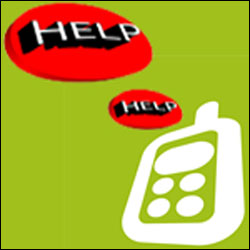Easy to use emergency mobile device for people at risk

Mobile phones can save lives in emergencies, but are not widely used among those considered to be most at risk: elderly people and sufferers of age-related and chronic diseases. A new device gives users the benefits of instant wireless communication, combined with location detection, without the complications of normal mobiles.
Validated for commercial use in the MobilAlarm project with funding from the European Commission’s eTEN Programme, the small and simple mobile device allows users to place a call to a service centre in the event of an emergency, while satellite positioning via GPS provides information about their location with an accuracy of 50 metres or less. Weighing less than a hundred grams and as small as a mobile phone but with four large and clearly discernible buttons, the device is easy to handle and above all straightforward to use.
“The design is very simple, it doesn’t have all the functions of a mobile phone, but that is what trial users most liked about it,” explains Stefan Lilischkis, the MobilAlarm project manager at coordinating partner empirica in Germany.
Though mobile phone penetration among people over 65 has increased sharply in Europe in recent years it still remains far below the rate for the broader population as elderly people struggle to come to terms with the dozens of complex features being packed into modern phones. They often find the small buttons hard to use, and the small text in displays and interfaces difficult to read, limiting the ease and speed with which an elderly person can contact someone when they are in need. Such problems are compounded if they are suffering from age-related frailty or Parkinson’s disease that impairs motor skills.
“The handset has two large buttons on the side that when pressed simultaneously initiate a call to the service centre. For people with diseases such as Parkinson’s this is an important feature because it allows a user to make an emergency call by simply gripping the device, rather than having to find and press a button,” Lilischkis says.
A separate button initiates a call to a pre-programmed telephone number, which could be that of a friend, relative or neighbour, while enhanced audio features mean the device does not have to be held up to the ear. Another button is for cancelling a normal phone call.
“When an emergency call is placed to a service centre the operator who takes the call automatically receives the user’s file on their computer, and, if necessary, can use the GPS tracking to obtain information about the location of the person on an electronic map,” the project manager says. “This is particularly important if emergency services are to find them quickly, especially if the person does not know where they are or are having difficulty speaking.”
Whereas existing mobile devices with location detection capabilities typically transmit GPS data via an SMS message, the MobilAlarm system uses the Care Phone Protocol developed by project partner Attendo Systems that transmits the data through the voice channel.
“This ensures that the information arrives instantly, compared to an SMS message which can take minutes or even hours to arrive depending on network traffic,” Lilischkis notes.
The GSM connection itself was shown to be particularly robust, allowing connectivity for emergency calls in places where normal mobile phones were unable to establish a connection.
The system was tested last year with around a hundred elderly users in the United Kingdom, Spain and Germany who were each given the device for at least three months. “The general response was very positive, they liked the simple design and thought the hearing quality was excellent,” Lilischkis says. “They also liked the peace of mind it gave them.”
Lothar Jennrich-Gügel, the founder of the German Parkinson Self Help Group, which was involved in the trials, notes, for example, how MobilAlarm would increase the quality of life of sufferers of the disease. “Parkinson patients could be very mobile but abhor going out because of the risk of facing a life-threatening situation. Based on this a mobile alarm system is urgently required,” he told the project.
Though elderly people and those suffering from chronic disease are the core market for the system, the MobilAlarm partners also see potential for it to be used by disabled but otherwise healthy people and possibly by victims of domestic violence or people carrying out hazardous jobs in remote locations.
Lilischkis says the commercial roll out of the system will probably target several user groups and involve both the public and private sector.
Media Contact
All latest news from the category: Information Technology
Here you can find a summary of innovations in the fields of information and data processing and up-to-date developments on IT equipment and hardware.
This area covers topics such as IT services, IT architectures, IT management and telecommunications.
Newest articles

Magnetic tornado is stirring up the haze at Jupiter’s poles
Unusual magnetically driven vortices may be generating Earth-size concentrations of hydrocarbon haze. While Jupiter’s Great Red Spot has been a constant feature of the planet for centuries, University of California,…

Cause of common cancer immunotherapy side effect s
New insights into how checkpoint inhibitors affect the immune system could improve cancer treatment. A multinational collaboration co-led by the Garvan Institute of Medical Research has uncovered a potential explanation…

New tool makes quick health, environmental monitoring possible
University of Wisconsin–Madison biochemists have developed a new, efficient method that may give first responders, environmental monitoring groups, or even you, the ability to quickly detect harmful and health-relevant substances…



